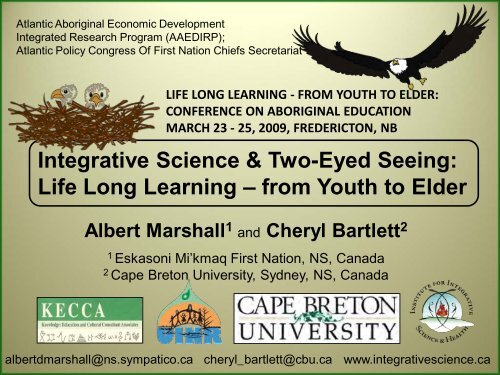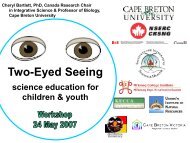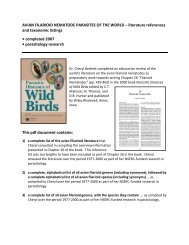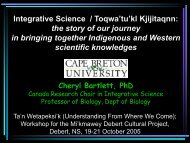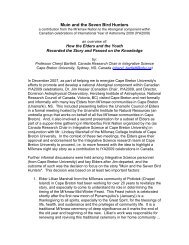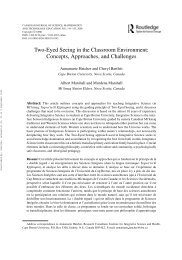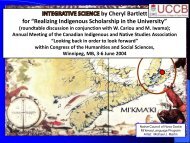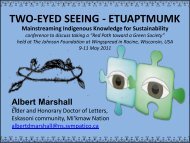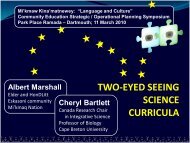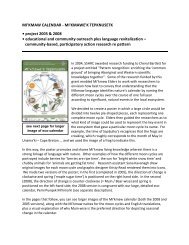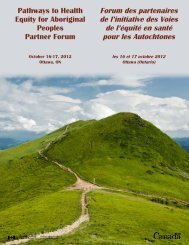presentation by Cheryl Bartlett and Albert Marshall - Integrative ...
presentation by Cheryl Bartlett and Albert Marshall - Integrative ...
presentation by Cheryl Bartlett and Albert Marshall - Integrative ...
- No tags were found...
Create successful ePaper yourself
Turn your PDF publications into a flip-book with our unique Google optimized e-Paper software.
Atlantic Aboriginal Economic DevelopmentIntegrated Research Program (AAEDIRP);Atlantic Policy Congress Of First Nation Chiefs SecretariatLIFE LONG LEARNING - FROM YOUTH TO ELDER:CONFERENCE ON ABORIGINAL EDUCATIONMARCH 23 - 25, 2009, FREDERICTON, NB<strong>Integrative</strong> Science & Two-Eyed Seeing:Life Long Learning – from Youth to Elder<strong>Albert</strong> <strong>Marshall</strong> 1 <strong>and</strong> <strong>Cheryl</strong> <strong>Bartlett</strong> 21Eskasoni Mi’kmaq First Nation, NS, Canada2Cape Breton University, Sydney, NS, Canadaalbertdmarshall@ns.sympatico.ca cheryl_bartlett@cbu.cawww.integrativescience.ca
ABSTRACT: <strong>Integrative</strong> Science & Two-Eyed Seeing: Life LongLearning – from Youth to Elder (A. <strong>Marshall</strong> <strong>and</strong> C. <strong>Bartlett</strong>)“<strong>Integrative</strong> Science” is defined as “bringing together Indigenous <strong>and</strong>Western scientific knowledges <strong>and</strong> ways of knowing”. It was created atCape Breton University in Sydney, Nova Scotia, in the mid-1990s. Ittries to be the radical innovation that key Mi’kmaq First Nation individualssuggested would be required to begin to address the shocking underparticipation<strong>by</strong> Aboriginal young people in university science programs<strong>and</strong> thus also in careers that require such education. The <strong>presentation</strong>will discuss challenges that 15 years of experience have shown<strong>Integrative</strong> Science can pose both inside <strong>and</strong> outside the educationalmainstream. “Two-Eyed Seeing” is an important guiding principle inhelping to address these challenges. It encourages that we learn to seefrom our one eye with the best in (or strengths of) the Indigenoussciences <strong>and</strong> from our other eye with the best in (or strengths of) theWestern sciences … <strong>and</strong> more: that we learn to use these two eyestogether, for the benefit of all. Abilities for “Two-Eyed Seeing” need tonurtured throughout a person’s life long learning journey; they also needto be encouraged starting very early in the formal educational years.
<strong>Cheryl</strong> <strong>Bartlett</strong>,Professor, CBU<strong>Albert</strong> <strong>Marshall</strong>,Elder, Eskasoni
our THANKS to many Elders & many othersChief CharlieDennisJane MeaderLillian<strong>Marshall</strong>http://www.science.ualberta.ca/Murdena <strong>Marshall</strong>LawrenceWellsSisterDorothyMoore
our THANKS to CBU’s Mi’kmaq Science Students
Thank you / Wela’lioq Mi’kmaq EldersEskasoni First Nation DetachmentThe support of variouspartners <strong>and</strong> funding agenciesis gratefully acknowledged.
PRESENTATION<strong>Integrative</strong> Science <strong>and</strong> Two-Eyed Seeing---------------------------------------------------------------------------------------------------• CHALLENGES re RADICAL INNOVATION in EDUCATION• INTEGRATIVE SCIENCE: a vision <strong>and</strong> why• TWO-EYED SEEING: a Journey of Life Long Learning• INTEGRATIVE SCIENCE: the program• SUPPORTING RESEARCH (includes Two-Eyed Seeing)• PROGRAM STRUCTURE <strong>and</strong> OUTCOMES• FIT with Aboriginal Learning Knowledge Centre (CCL)• HOW radically innovate in university environment• CHALLENGES: ongoing <strong>and</strong> new
Challenges (reflections on 15+ years)• conceptual (science?)• political (systemic racism? +?)• jurisdictional (whose program?)• structural (what kind of program?)• financial (resources?)• instructional (who can / should?)• physical (where?)• pedagogical (how?)• recruitment (who <strong>and</strong> how?)• audience (why <strong>and</strong> whose needs?)• pragmatic (students’ lives?)• definitional (what is “success”?)• pragmatic (graduates do what?)• capacity development (how nurture & make sustainable?)
Artist Basma Kavanagh
<strong>Integrative</strong> ScienceIndigenousWestern“bringing our knowledges worldviews sciences stories together”Artist Basma Kavanagh
<strong>Integrative</strong> Scienceour sciencesour storiesour worldviewsWestern“bringing our knowledges together”IndigenousArtist Basma Kavanagh
Indigenous <strong>and</strong> Westernscientific knowledges arebased in observationsof the natural world.view “SCIENCE”inclusivelyArtist Basma Kavanagh
Indigenous <strong>and</strong> Westernscientific knowledges arebased in observationsof the natural world.view “SCIENCE”inclusively“stories of our interactionswith <strong>and</strong> within nature”Science is dynamic,pattern-based knowledge.Artist Basma Kavanagh
15+ years ago we started aCo-Learning Journey. WHY?31 reasons2Artist Basma Kavanagh
Why?1Native Council of Nova ScotiaMi’kmaq Language ProgramArtist: Michael J. Martinfew Aboriginal studentsin post-secondary science
Why?2many Aboriginal youth
Why?2Because today …Mi’kmaq <strong>and</strong> other Aboriginal youthare poised on the edge of two worlds.IndigenousWestern
Why?2Because today …Mi’kmaq <strong>and</strong> other Aboriginal youthare poised losing their on the cultural edge of connections.two worlds.IndigenousWestern
Why?2Because …health (individuals & communities) <strong>and</strong> transmission ofTraditional Knowledge are strongly related(source: Elders & others)IndigenousWesternmodel & visual from: CINDY BLACKSTOCKhttp://www.win-hec.org/docs/pdfs/cindy.pdf (WIN-HEC Journal 2007)
Why?2Because …health (individuals & communities) <strong>and</strong> transmission ofTraditional Knowledge are strongly related(source: Elders & others)IndigenousWesternmodel & visual from: CINDY BLACKSTOCKhttp://www.win-hec.org/docs/pdfs/cindy.pdf (WIN-HEC Journal 2007)
Why?3IndigenousWesternThe central dilemma of scienceeducation today is the teaching ofscience from only one culturalperspective, <strong>and</strong> in an incomplete<strong>and</strong> non-connected manner.Gregory Cajete, PhDNative American Scientist & Educator, Univ. of New Mexico
starting in the mid 1990’s15+ years: where ourCo-Learning Journeyhas been<strong>Integrative</strong> Sciencebringing together Indigenous <strong>and</strong> Westernscientific knowledges <strong>and</strong> ways of knowingIndigenousWestern
<strong>Integrative</strong> ScienceIndigenousWestern“bringing our knowledges worldviews sciences stories together”Artist Basma Kavanagh
CO-LEARNING & LIFE LONG LEARNING:VIEWS FROM AN ELDERTwo-EyedSeeingElder <strong>Albert</strong> <strong>Marshall</strong>Eskasoni community, NSMi’kmaq Nation
A Guiding Principle“LEARN ... to see from oneeye with the best inour Indigenousways of knowing,<strong>and</strong> from the othereye with the best inthe Western (ormainstream) waysof knowing … <strong>and</strong>to use both theseeyes together, for the benefit of all.”Artist Basma Kavanagh
Two-Eyed Seeingteaches you awakenthe spirit within you.You becomea student of life …<strong>and</strong> you becomeobservant of thenatural world …<strong>and</strong> realize wehumans are part<strong>and</strong> parcel of thewhole.
Two-Eyed Seeing teaches thateverything is physical <strong>and</strong> spiritual.It teaches about ourinterconnectivenesswith the natural world… <strong>and</strong> about ourresponsibilities for thenext SevenGenerations.
Our language teaches usabout interdependence.Nature has rights.Humans have responsibilities.
Our language teaches usthat everything alive isboth physical <strong>and</strong> spiritual.The onus is on theperson to look at ournatural world withtwo perspectives.Modern sciencesees objects,but our languageteaches us to seesubjects.Artist Basma Kavanagh
Humans are a very smallpart of the whole.Our biggest responsibilityhas to be to speak forthose species thatcannot speak forthemselves.Our natural worldprovides for us,shelters us, nourishes us.from:Mi’kmaq Family& Children’sServices
Water … Air … Earth
Our language takesus into aLife Long Journey.Artwork <strong>by</strong> children at Eskasoni Elementary SchoolArtist Basma Kavanagh
Knowledge is not a toolbut rather it is a spirit.It transforms theholder. It alsoreminds us that wehave responsibilitiesto the spirit of thatknowledge.We must pass it on.Artist Basma Kavanagh
Seven GenerationsArtist Basma Kavanagh
Netukulimkdeveloping the skills <strong>and</strong>sense of responsibilityrequired to become aprotector of other specieshttp://myanimalblog.files.wordpress.com/2008/03/g-bull-moose.jpghttp://blog.silive.com/weather/2007/09/red-maple-tree.jpghttp://www.greenexp<strong>and</strong>er.com/wpcontent/uploads/2007/09/gex-bald-eagle.jpghttp://www.krisweb.com/krissheepscot/krisdb/html/krisweb/aqualife/atlantic_salmon_asc_bel<strong>and</strong>.jpg
Tatapn(North Star)Muin <strong>and</strong> the Seven Bird Hunters:a Mi’kmaq Night Sky Story… interconnectiveness ofspace-time-life-knowledge-spirit
Tatapn(North Star)Muin <strong>and</strong> the Seven Bird Hunters:a Mi’kmaq Night Sky Story… interconnectiveness ofspace-time-life-knowledge-spirit
starting in the mid 1990’s15+ years: where ourCo-Learning Journeyhas been<strong>Integrative</strong> Science / Two-Eyed Seeingbringing together Indigenous <strong>and</strong> Westernscientific knowledges <strong>and</strong> ways of knowingIndigenousWestern
Co-Learning Journeyvisual model from:Murdena <strong>Marshall</strong>, 2008Traditional Health <strong>and</strong> Healing;Health Workshop ModuleFROM: one ethnobotany course (1996)TO: a full, four year science degree (2001)
Co-Learning Journeypraxis-basedRESEARCH• integrative• community-based• participatory• actionmethodologies
4 “BIG PATTERN”KNOWLEDGEUNDERSTANDINGSontologiesepistemologiesmethodologiesgoalsput our values + actions+ knowledges in front ofus ... like an objectuse VISUALS
“Two-Eyed Seeing”learning learning to to see see with with the the strengths strengthsof of each each && together togetherOUR KEY VALUES <strong>and</strong> ACTIONS- respect- relationship- reverence- reciprocity- ritual (ceremony)- repetition- responsibilityJ. Archibald, 2001, Can. J. Native Ed. 25(1):1-5Two-Eyed SeeingEPISTEMOLOGY- hypothesis(making & testing)- data collection- data analysis- model & theoryconstruction
Challenges (reflections on 15+ years)• conceptual (science?)• political (systemic racism? +?)• jurisdictional (whose program?)• structural (what kind of program?)• financial (resources?)• instructional (who can / should?)• physical (where?)• pedagogical (how?)• recruitment (who <strong>and</strong> how?)• audience (why <strong>and</strong> whose needs?)• pragmatic (students’ lives?)• definitional (what is “success”?)• pragmatic (graduates do what?)• capacity development (how nurture & make sustainable?)
The Greatest Challenge“SUCCESS”What is it?How measure it?How nurture it?need for new underst<strong>and</strong>ings <strong>and</strong>policies to support life long learning
The measurements cannot be thoseof the mainstream. St<strong>and</strong>ards willbe much higher <strong>and</strong> assessmentwill be <strong>by</strong> the Elders. They willensure that authenticity is there.“SUCCESS”We must look to the Elders to guidethe measuring methodologies.Elders know it is their culture, their children’s lives,<strong>and</strong> their communities’ long term health that are onthe line. And, they know language is very important.
Nature clearly teachesus this lesson:Seeds germinatewhen the environmentis appropriate.Elders know that Traditional Knowledge willtransform the learner, even though manyyears may be required to see this.
How?PART1) Innovative science degree• degree profile- 40 courses (120 credits)- 2 work placements (non credit)• conventional courses: 32 of 40• innovative courses: 8 of 402) Innovative science courses (MSIT)• integrative framework• curricular components• pattern recognition & transformationPART -
4 yr Science Degree Program1) core2) concentration3) electives4) work placementsCREDITS: 48Science: inquiry (3 core)Plus: perspectives*& skills*CREDITS: 42Science: university &applied (tech)CREDITS: 30Science: all, some, noneCREDITS: 0Science: experience
401 & 403MSITscience courses4 th3 rd301 & 303101 & 103 201 & 2031 styear withindegree program
How?1Mi’kmaq community Elders,resource people & organizations,TK events in community6co-learningRESEARCHTK literature5Western science: cosmology-physicschemistry-geology-biology-consciousness423studentsout-of-doorsAboriginal concepts,pedagogy, language
ENTRY viaMSAP =facilitatedfirst year:- four MSITsciences- plus othercoursesMSAP(Mi’kmaq Science Advantage Program)
Mi’kmaq <strong>Integrative</strong> Science Students 1999-20091 st Year+ + +3 rd Year4 th Year
Mi’kmaq Science Graduates 2003-2008(with all or some relationship to <strong>Integrative</strong> Science)112 2 3 1 213215111211112223TOTAL
Program: success or other … what is it?• students graduated with BScCS - Int Scinow working in community <strong>and</strong>/or pursuing additional highereducation (e.g. BEd, BScN, BTech-Environ)• students completed 1 st year Int Scinow enrolled in or graduated from other degreeprograms (science, science-related, <strong>and</strong> other)≈ 40• students ‘experienced’ 1 st or more years Int Scinow on ‘pause’ (e.g. working or raising family) but hope tocomplete science studies at some future point• students ‘experienced’ 1 st year Int Scileft university; current status not known≈ 80
Program: success or other … what is it?• students graduated with BScCS - Int Scinow working in community <strong>and</strong>/or pursuing additional highereducation (e.g. BEd, BScN, BTech-Environ)• students completed 1 st year Int Scinow enrolled in or graduated from other degreeprograms (science, science-related, <strong>and</strong> other)≈ 40• students ‘experienced’ 1 st or more years Int Scinow on ‘pause’ (e.g. working or raising family) but hope tocomplete science studies at some future point• students ‘experienced’ 1 st year Int Scileft university; current status not known≈ 80
Seedsgerminatewhen theenvironmentis appropriate.TheGreatestChallengeWhat is “SUCCESS”?
First Nations Holistic Lifelong Learning Modelfrom: Canadian Council on Learning: Aboriginal Learning Knowledge Centre(http://www.ccl-cca/CCL)
First Nations Holistic Lifelong Learning Modelfrom: Canadian Council on Learning: Aboriginal Learning Knowledge Centre(http://www.ccl-cca/CCL)
First Nations Holistic Lifelong Learning Modelfrom: Canadian Council on Learning: Aboriginal Learning Knowledge Centre(http://www.ccl-cca/CCL)
<strong>Integrative</strong> ScienceIndigenousFirst Nations Holistic Lifelong Learning ModelWesternfrom: Canadian Council on Learning: Aboriginal Learning Knowledge Centre(http://www.ccl-cca/CCL)
<strong>Integrative</strong> Science&Two-Eyed SeeingK-12CHALLENGESPSELIFE LONG CO-LEARNING (for us all)need for advocacy re social, economic, <strong>and</strong> educationpolicies to support life long learning
Many, many contributions are neededto nurture success … collective <strong>and</strong>collaborative efforts are essential.Wela’lioqThank you
Thank you / Wela’lioq Mi’kmaq EldersEskasoni First Nation DetachmentThe support of variouspartners <strong>and</strong> funding agenciesis gratefully acknowledged.
The Atlantic Aboriginal Economic DevelopmentIntegrated Research Program, AAEDIRPLIFE LONG LEARNING - FROM YOUTH TO ELDERCONFERENCE ON ABORIGINAL EDUCATIONMARCH 23 - 25, 2009, FREDERICTON, NEW BRUNSWICKATLANTIC POLICY CONGRESSOF FIRST NATION CHIEFSSECRETARIAT
Day 1: Monday, March 23 rd , 2009DRAFT CONFERENCE PROGRAMTIME WU CENTRE, UNIVERSITY OF NEW BRUNSWICK LOCATION1:00 - 5:00pm1:00 – 2:00pmRegistration, Booths, <strong>and</strong> Poster SessionsPoster Session Presentations:• Summer Science Camps for Youth, Mi’kmaq Maliseet Institute - AmberGiles, Undergraduate Student, Mi`kmaq Maliseet institute, University ofNew Brunswick• Mi’kmaq Maliseet Bachelor of Social Work Programme - S<strong>and</strong>ra Germaine,Coordinator• Transforming Mathematics education for Mi’kmaq students throughmawikinutimatimk - Lisa Lunney Borden, Ph.D C<strong>and</strong>idate, Saint FrancisXavier University• Eskasoni Mi’kmaw Elder’s Program - Elders Elizabeth, B. Ed., Mi’kmaqLanguage Teacher <strong>and</strong> Curriculum Consultant for Elders Program, EskasoniSchool. She has her B.Ed.• Paul <strong>and</strong> Barbara Sylliboy, Eskasoni School• Aboriginal Literacy Project - Nora McCarthy, Research Program Coordinator,Community-Based Research, University of Prince Edward Isl<strong>and</strong>3:00 - 5:00pm Opening Ceremony: Master of Ceremonies/Moderator: Bob Atwin, ExecutiveDirector, First Nation Education Initiatives, Kingsclear First NationOpening Prayer:• Elder Gwen Bear, Tobique First NationWelcome Remarks: Chief C<strong>and</strong>ice Paul, St. Mary`s First Nation, WolastoqiyikOpening Remarks:• APCFNC Co-Chair, Chief Noah Augustine, Metepenagiag First Nation• APCFNC Co-Chair, Chief Lawrence Paul, Millbrook First Nation• Representative of the Province of New Brunswick• President of the University of New Brunswick, Dr. John McLaughlin6:30 - 9:00pm Registration <strong>and</strong> Welcome ReceptionWelcoming Remarks:• Master of Ceremonies: Bob Atwin• Keynote Address: Honorable Graydon Nicholas, New Brunswick ProvincialCourt Judge, Tobique First Nation• AAEDIRP Aboriginal Co-Chair <strong>and</strong> Executive Director, John G. Paul, APCFNC,• AAEDIRP University Co-Chair, Dr. Fred Wien, School of Social Work,Dalhousie University• Honorable Andy Scott, Andrews Senior Fellow in Social Policy, Departmentof Sociology, University of New Brunswick• John Kershaw, Deputy Minister of Education, Province of New Brunswick• Mark Davis, Director of Government Relations, Indian <strong>and</strong> Northern AffairsCanadaPresentation: “The Atlantic Aboriginal Economy Building Strategy”Atlantic Aboriginal Economic Developers Network, (AAEDN), Co-Chairs:Economic Development Officer (EDO), Sacha Labillois, Eel River Bar First Nation<strong>and</strong> EDO Louis Joe Bernard, Union of Nova Scotia Indians, Waycobah FirstNationFoyer,Chancellor’s RmKent AuditoriumFREDERICTON INN,Royal StewartRoom
Day 2: Tuesday, March 24 th , 2009TIME WU CENTRE, UNIVERSITY OF NEW BRUNSWICK LOCATION7:30 - 8:45 am BREAKFAST8:00am - Registration, Booths, Poster SessionsOngoing9:00 - 9:15am Opening Prayer Introduction of Session Theme: LANGUAGE AND SYSTEMS OF KNOWLEDGE• Moderator: Bob Atwin9:15 - 9:50am PLENARY SPEAKERS “<strong>Integrative</strong> Science <strong>and</strong> Two Eyed Seeing”• Elder <strong>Albert</strong> <strong>Marshall</strong>, Eskasoni First Nation• <strong>Cheryl</strong> <strong>Bartlett</strong>, Tier 1 Canada Research Chair in <strong>Integrative</strong> Science, Directorof the Institute for <strong>Integrative</strong> Science & Health <strong>and</strong> Department of Biology,Cape Breton University9:50 - 10: 30am “Border Crossings in Education - Development of Innu-centered EducationalModel”• Valerie Courtois, Forestry Planner, Innu Nation Environment Office,Sheshatshiu Innu First Nation• Dr. Trudy Sable, Director, Office of Aboriginal <strong>and</strong> Northern Research,Gorsebrook Research Institute <strong>and</strong> Department of Anthropology, SaintMary’s University10:30 -10:45am BREAKLANGUAGE AND SYSTEMS OF KNOWLEDGE: WORKSHOP A10:45 - “Documented Spoken Wolastoq/Maliseet in Educational, Spiritual & Cultural11:20am Context”• Dave Perley, Mi’kmaq Maliseet Institute, University of New Brunswick,Tobique First Nation; Imelda Perley, Mi’kmaq Maliseet Institute, Universityof New Brunswick, Tobique First Nation; Gwen Bear, Tobique First Nation;Dr. Evelyn Plaice, Faculty of Education/ Department of Anthropology,University of New Brunswick11:20 - “Inuit Elders <strong>and</strong> Youth Project: Developing a new online multimedia resource:11:55am www. InuitQ.ca,”• Dr. Cynthia J. Alex<strong>and</strong>er, Department of Political Science, Acadia University10:45 -11:20am11:20 -11:55am10:45 -11:20amLANGUAGE AND SYSTEMS OF KNOWLEDGE: WORKSHOP B“Show me Your Math - Inviting Community Knowledge into the MathematicsClassroom”• Lisa Lunney Borden, Ph. D C<strong>and</strong>idate, School of Education, St. Francis XavierUniversity; Dr. David Wagner, Faculty of Education, University of NewBrunswick“International Research”• Andrea Bear Nicholas, Chair in Native Studies, St. Thomas University,Tobique First NationLANGUAGE AND SYSTEMS OF KNOWLEDGE: WORKSHOP C“Summary of Eskasoni Mi’kmaq Immersion Program Research”• Starr Sock, Eskasoni Immersion Program, Eskasoni First Nation; Dr. JoanneTompkins <strong>and</strong> Dr. Anne Murray, School of Education, St. Francis XavierUniversityFoyer,Chancellor’s RmKent AuditoriumKent AuditoriumKent AuditoriumKent AuditoriumRoom 203Room 204
11:20 - “Eskasoni Mi’kmaq Immersion in the School”11:55am• Ida Denny, Eskasoni Immersion Program; Starr Sock, Eskasoni School12:00 - 1:00pm LUNCH <strong>and</strong> Keynote Speaker:Jarrett Laughlin, Senior Research Analyst, Canadian Council of Learning1:10 - 1:25pm Introduction of Session Theme: RETENTION RATES AND SUCCESS STRATEGIESModerator: Bob Atwin1:25 - 2:00pm PLENARY SPEAKERS “Community Best Practices, Eel Ground First Nation”• Chief George Ginnish, Education Director, Eel Ground First Nation2:00 - 2:35pm “Career Counseling” • Karen Atwin, Dragonfly Solutions, Kingsclear First Nation2:35 - 2:50 pm BREAKRETENTION RATES AND SUCCESS STRATEGIES: WORKSHOP D2:50 -“Community Incentives”3:25pm• Chief Joanna Bernard, Education Director <strong>and</strong> AAEDIRP Steering Committee,Madawaska First Nation; Bob Atwin, First Nation Education Initiatives3:25 -“Success in School for Mi’kmaq Learners, A Mixed Methods Study of Education4:05pm Experiences”• Dr. Fiona Walton, Faculty of Education, University of Prince Edward Isl<strong>and</strong>;Nancy Peters, Lennox Isl<strong>and</strong> First Nation, B.Ed C<strong>and</strong>idate, UPEI,Specialization in Indigenous Education; Danielle Frenette, M.Ed. C<strong>and</strong>idate,UPEI2:50 -3:25pm3:25 -4:05pm2:50 -3:25pm3:25 -4:05pm2:50 -3:25pm3:25 -4:05pmRETENTION RATES AND SUCCESS STRATEGIES: WORKSHOP E“Strategies for Improving Systemic Problems In Aboriginal Education: Supports toAssist Underachieving Students”• Isabel den Heyer, den Heyer Associates; Dr. Fred Wien, Dalhousie University“SAYIT Mentoring Program - St. Mary’s Aboriginal Youth Independence Team”• Bonita Polches, Aboriginal Student Guidance Counselor, Leo Hayes HighSchool, St. Mary’s First NationRETENTION RATES AND SUCCESS STRATEGIES: WORKSHOP F“Important Supports in Communities - Eel River Bar Boys <strong>and</strong> Girls Club”• Chastity Labillois, Eel River Bar First Nation“Mi’kmaw Kina’matnewey School Improvement Program”• Laurianne Stevens, School Improvement Coordinator, Mi’kmawKina’matnewey, Membertou First NationRETENTION RATES AND SUCCESS STRATEGIES: WORKSHOP F“ A Study of the Atlantic Aboriginal Post-Secondary Labour Force”• Pat Sark, First Nation Education Initiatives, Oromocto First Nation; DavidBruce, Director, Rural/Small Town Program, Mount Allison University“Aboriginal Student Retention: Association of Atlantic Universities”• Dr. Laurel Lewey, Social Work Department, St. Thomas University <strong>and</strong>AAEDIRP Steering Committee; Dr. Trudy Sable, Director, Office of Aboriginal<strong>and</strong> Northern Research, Gorsebrook Research Institute <strong>and</strong> Department ofAnthropology, Saint Mary’s University;6:30 - 9:00pm BANQUETKeynote Speaker: Peter Garrow, Education Director, Assembly of First Nations,OttawaEntertainment: Presentation - Eel Ground Youth Drama Club - Chief George GinnishRoom 204Kent AuditoriumKent AuditoriumKent AuditoriumKent AuditoriumKent AuditoriumChancellor’s RmRoom 203Room 204FREDERICTONINN, RoyalStewart Room
Day 3: Wednesday, March 25 th , 2009TIME WU CENTRE, UNIVERSITY OF NEW BRUNSWICK LOCATION7:30 - 8:45am BREAKFAST9:00 - 12:00pm Booths <strong>and</strong> Poster Sessions Foyer9:00 -Kent Auditorium9:15am9:15 -10:30amIntroduction of Group Discussions <strong>and</strong> Session Theme: Moderators: Bob Atwin<strong>and</strong> Dr. Fred WienTOWARDS DEVELOPING AN ATLANTIC BASED INTERVENTION STRATEGY ONABORIGINAL YOUTH HIGH SCHOOL COMPLETIONGroup 1 Facilitated DiscussionGroup 2 Facilitated DiscussionGroup 3 Facilitated Discussion10:30 - 10:45am BREAK10:45 am - Group Reports <strong>and</strong> Conference Wrap-Up: Moderator: Bob Atwin12:00 pm Closing Prayer12:00 -1:00pmLUNCHThank you to our Poster Presenters <strong>and</strong> to the following organizations for settingup BOOTHS:• Mi’kmaq Maliseet Atlantic Youth Council - Ashley Julian & CurtisBartibogue• Council for Advancement of Native Development Officers - Anita Boyle• Mi’kmaq Maliseet Institute, University of New Brunswick - Lynda Doige• Mi’kmaq Maliseet Bachelor of Social Work Programme - S<strong>and</strong>ra Germaine• Story Sack Teaching Tool - Sheila Francis, Pictou L<strong>and</strong>ing First Nation• Listuguj Language Project - Joe Wilmot• Atlantic Canada’s First Nation Help Desk - Lauretta Walsh• Mi’kmaw Kina’matnewey - Lauretta Walsh• Aboriginal Health Human Resource Initiative - Krista Hanscomb, SaintFrancis Xavier University Session will be available <strong>by</strong> video conference to participating communitysites courtesy of Atlantic Canada’s First Nation Help Desk. Call toll free: 1(877) 484 7606 or email: admin@firstnationhelp.com to register. Or go to http://firstnationhelp.com/livevideo to view live web streamingof this session on the internet. The sessions will also be available afterthe conference.The Conference Organizing Committee thanks you for attending <strong>and</strong> wishes you asafe journey back home…Sincerely, Pam Ward, Conference Coord.; Gillian Austin,Asst. Research Coordinator, AAEDIRP; Darcy Pirie, Admin. Assistant, AAEDIRP; BobAtwin, Exec. Director, First Nation Education Initiatives; Dr. Susan Blair, Dept. ofAnthropology, University of New Brunswick; John Sylliboy, Aboriginal Health HumanResource Initiative Coord., APCFNC; John J. Paul, Dir. of Program Services, Mi’kmawKina’matnewey; Ashley Julian, Youth Coordinator, APCFNC, Mi’kmaq Maliseet AtlanticYouth CouncilKent AuditoriumRoom 203Room 204Kent Auditorium


